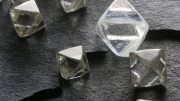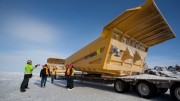In the space of just a few months, both BHP Billiton (BHP-N, BLT-L) and Rio Tinto (RTP-N, RIO-L) announced they were reviewing their diamond businesses. BHP, the 80% owner of Canada’s first diamond mine, Ekati, was the first out of the gate in November, with Rio, the 60% owner of Canada’s second mine, Diavik, following suit in March.
The two companies made waves by getting into the diamond industry, first Rio Tinto with its Argyle mine in the 1980s, and
later, BHP with Ekati. Now they want out.
Coming at a time of recovery for the diamond industry, and when the fundamentals have never looked better, the announcements did nothing to revive investor interest in the sector — which has been slow to return even with the dramatic post-recession recovery of diamond prices.
But the decision wasn’t prompted by the outlook for diamonds (which all agree is bright), and many in the industry believe it will actually have a positive impact on the sector.
BHP and Rio Tinto, respectively the first and third-largest mining companies in the world, mine mostly bulk commodities across the globe. In that context, diamonds were always an anomaly for them, says Brooke Clements, the president of Peregrine Diamonds (PGD-T).
“These companies are known for bigtonnage operations and a control position in commodities. Diamonds never really fit in there anyway,” he said, adding that the companies’ diamond divisions only account for a tiny fraction of their bottom lines.
BHP also owned a 51% interest in the Chidliak advanced exploration project, in Nunavut, with 49% partner Peregrine. In December, Peregrine made a deal to acquire BHP’s stake for staged payments totalling $9 million.
Another factor for the majors is the lack of top-tier assets in the diamond space, which both companies cited as reasons for their reviews.
“BHP Billiton’s strategy is to invest in large, long life, upstream and expandable assets while remaining a simple and scalable
organization,” read BHP’s release. “Ekati is a world-class operation and Chidliak is a promising exploration opportunity, but
many years of extensive exploration suggest there are few options to develop new diamond mines that are consistent with this approach.”
In a report in April, Australia-based Nomura Equity Research noted that even huge companies have limited resources, and that the diamond divisions of BHP and Rio Tinto might find it hard to compete for capital and attention from management.
“Both companies have extensivegrowth pipelines in bulk commodities, energy and base metals, which have higher potential returns and earnings impact,” the report says. Nomura estimates that diamonds only make up around 1% of each company’s net present value.
Chad Ulansky, president and CEO of Metalex Ventures (MTX-V), which owns the U2 project in northern Ontario, notes that BHP in particular is making a strategic shift towards potash and has already redeployed some of its diamonds staff towards the fertilizer.
“I think what you’re seeing is a focus of their existing expertise away from diamonds and into potash because that’s potentially a much more significant commodity for them — it’s scalable, it’s tens of billions of dollars if not hundreds of billions of dollars market rather than a couple of billion that the diamonds are.”
As a co-discoverer of BHP’s Ekati mine, Metalex chairman Chuck Fipke owns 10% of it.
Lastly, BHP’s and Rio’s mines are all late-life assets transitioning to more expensive underground operations. Rio Tinto is currently spending US$2.1 billion at its huge Argyle mine in Australia to extend the mine life to 2019. Ekati has about six or seven years of mine life left, while Diavik has about ten. And even though the assets all have growth potential, the diamond market simply isn’t big enough for these behemoths to make further investment worthwhile.
Potential buyers
The asset sales may provide an opportunity for mid-tiers to step up the food chain and become bigger fish in the shrinking pond that is the global diamond industry.
“There is the ability for somebody to consolidate the diamond industry again, similar to what De Beers did prior to BHP and Rio Tinto in large part breaking their monopoly 20 years ago,” Ulansky says. “It does leave an interesting opportunity for some of the mid-tiers, whether that’s Gem Diamonds or Harry Winston or Petra Diamonds, to become more significant players.”
Until it announced its review of its diamonds portfolio, which includes Argyle, a 78% interest in the Murowa mine in Zimbabwe, and the Bunder advanced exploration project in India, Rio Tinto was initially seen as a potential buyer of BHP’s diamond assets.
Now that Rio’s out, there are no obvious buyers for all the aging mines that have been slapped with “for sale” signs. Rio’s diamond business is valued at about $2 billion, while BHP’s Ekati stake is valued at US$500 million.
One of the more intriguing possibilities, reported in April, is that investment firm Kolberg Kravis Roberts & Co. will buy and combine the assets of both majors, listing the resulting entity in London.
Given that the largest diamond producers, De Beers and Alrosa, are unlisted, this could reignite interest in the diamond space. To the same effect, the mention of a possible “different ownership structure” in Rio’s announcement has led to speculation that it may spin off its diamond unit itself.
Other possibilities include a sale to Harry Winston Diamond (HW-T, HWD-N), which Bloomberg has reported is interested in Ekati, De Beers and Petra Diamonds (PDL-L).
As a 40% owner of Diavik, Harry Winston would seem a natural buyer for Rio’s majority stake in the mine. But in a note to clients, BMO Capital Markets mining analyst Edward Sterck wrote that isn’t necessarily the case.
“Although Harry Winston’s mining division is debt free, on BMO Research’s estimates, buying Rio’s interest in Diavik is likely too large to be digestible without a strategic partner. Furthermore, as Harry Winston does not currently operate Diavik, it can be argued that it lacks the necessary in-house mining expertise.”
If De Beers, which currently produces 25% of the world’s diamonds by volume and 37% by value, were to pick up BHP’s and Rio’s assets, it would have 51% of the market by value, says U.K.-based mining analyst David Hargreaves, the author of the newsletter The Week in Mining.
However, that could raise competition concerns. The company is also going to be drawing on its financial resources to expand
existing mines and to build its 51%-owned Gahcho Kué mine, in the Northwest Territories, a joint venture with Mountain Province Diamonds (MPV-T).
De Beers isn’t providing any hints on whether it’s even interested.
“We are here to grow the business. We will look at any sensible opportunity, but we will never comment on it,” said De Beers CEO Philippe Mellier at the Reuters Mining and Metals summit in New York in late March.
Petra Diamonds, which owns several former De Beers mines in South Africa, Botswana and Tanzania, is on track to become a 5 million carat per year producer by 2018 (up from 2 million carats this year). Acquiring both BHP and Rio’s diamondsassets could propel it 20 million carats a year and the fourth-largest diamond miner in the world, says Hargreaves.
“It’s a sound one because it’s based on big mines with big resources — now they’re expensive mines — Finsch, Cullinan, the old Kimberley mine, but it’s good product, it’s solid and it’s in a good jurisdiction,” Hargreaves says.
He adds they’re well backed by middle eastern money in the form of Al Rajhi Holdings.
However, in an interview with Reuters in early March, Petra CEO Johan Dippenaar noted that the company is focused on internal growth.
“Will it create an opportunity for us? I am not sure. Any of those assets are well within our ability to manage, that isn’t a problem at all, but we have also just announced that we have made a very interesting discovery in Botswana. . . and we have a very ambitious growth profile from our existing portfolio.”
After making an initial approach for Ekati, London-listed Gem Diamonds (GEMD-L) has already taken itself out of the running.
“Our approach to valuation didn’t meet the sellers’ expectations,” CEO Clifford Elphick told Reuters in March. “We were a bit stingy, if the truth be told.”
As for Russia’s Alrosa, expansion outside of Russia may not be politically palatable for the state-owned company. Competition issues may also preclude any big moves on its part.
Outside of the obvious suspects, Bloomberg has reported that Eira Thomas, formerly of Stornoway Diamond (SWY-T), is one of several parties interested in buying the mine.
There is a possibility that neither BHP nor Rio will find suitable buyers, as anyone taking on their late-life assets would need to handle reclamation, an expensive and time-consuming process.
“I suspect after these reviews are completed it could be that BHP and Rio Tinto come to the conclusion that there isn’t anyone of high enough calibre to sell to,” BMO’s Sterck told The Northern Miner in March.
Impact on juniors
It’s too early to gauge all the implications of Rio Tinto and BHP’s leaving the industry. In a tough financing environment for Canada’s junior diamond explorers and developers, it could mean fewer potential sources of cash, partnership and expertise.
“The opportunities to joint venture a project off to BHP and Rio presumably are going to be extremely limited,” says Metalex’s Ulansky. “So in all likelihood, you’ll see us having to arrange the finance and potentially expertise to go through mine development through alternate methods, whether that’s done in-house or by contract miners or perhaps by joint venture arrangements with some of the mid-tiers.”
Metalex recently roped a deal with Dundee that could see the bank pay $51 million in expenses at its U2 project in northern Ontario in return for a 51% stake.
On the other hand, if the right buyer comes along for BHP and Rio’s assets, it could mean more interest and money for Canada’s struggling juniors.




Be the first to comment on "Unable to go big, BHP and Rio Tinto go home"